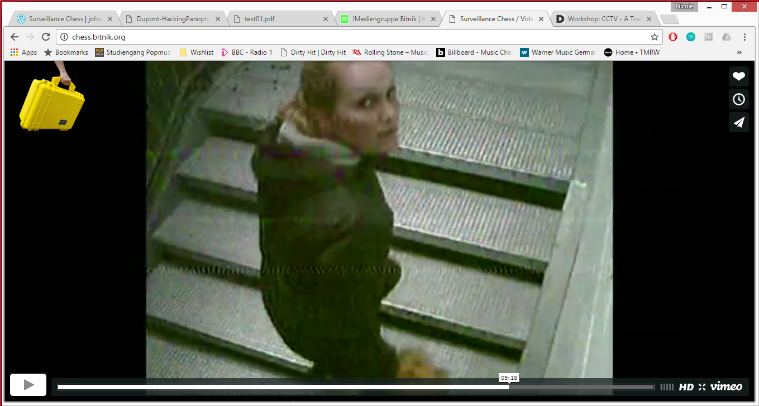Swiss media activists “Bitnik” use a jamming transmitter to hijack security cameras in the London Underground and invite the security personnel to a game chess on their screens. This form of guerrilla artivism skilfully reverses the imbalance of power between those being observed and those doing the observing.
The video project Surveillance Chess (2012) – Hijacking CCTV Cameras in London documents an attempt at artistic intervention into the urban surveillance system as a form of ‘artivism’, i.e. art activism. This intervention highlights the underlying asymmetry of power defining the current surveillance system and briefly dissolves this hierarchy between the surveilling and the surveilled. The video was produced shortly before the Olympic Games in London by Bitnik media group, a collective mainly concerned with criticism of digital media. Besides being hosted on Vimeo, the video is accessible through the artists’ own website as well as a specially designed homepage for the project.
Surveillance Chess begins with a text overlay describing the clip’s setting: London, 2012. Throughout the following seven-minute video, the individual sequences do not form a coherent narrative chain of action, but rather a series of repeated actions distinguished by abrupt jumps in time and space. The following pattern is repeated several times across varying locations:
A woman, apparently a member of the media group Bitnik, walks into view at a public, often crowded space, a yellow suitcase in hand. She then sets the suitcase down, making sure to do so well within view of the camera, and presses a switch. This is an act of manipulation, of hijacking: Bitnik intercept the camera’s signal, assuming control over the live feed and replacing the real-time footage on the monitors in the control room with the image of a chessboard – coupled with a challenge: „I’ve hijacked your surveillance camera! I’m the one with the yellow suitcase. How about a game of chess? You are white. I am black. Call me or text to make your move! This is my phone number: 075 8246 0851″. Meanwhile, the chequerboard pattern and the regular camera feed alternate in rapid succession, forming a chain of surveillance and counter-surveillance images.
In an attempt to replicate the visual style of genuine surveillance footage, the entire video’s aesthetics is dominated by a grayscale colour palette and low saturation, while white noise and visual glitches enhance the impression of authenticity throughout the entire video.
As the clip is filmed from an elevated camera perspective, the events are shown from a superior position, thereby visualising the unequal „balance of power between a seemingly omniscient, all-seeing and untouchable observer and an uninformed observed object lacking a voice of its own”[1].
On the acoustic level, too, the video indicates authenticity, capturing the background noise of the public spaces.
The text slides (“I’ve hijacked your surveillance camera”) are also read aloud by a computer-generated female voice, highlighting the invitation to a game of chess and making this form of unusual communication more personal. The operator behind the screen in the control room is not only visually, but also audibly confronted with the fact that someone has hijacked their security cameras, momentarily wrestling control away from them, and that she has in turn extended an invitation from a position of brief superiority. The operator, in short, experiences a brief, but total loss of control.
Deliberate stylistic repetition defines the entire video – not only the editing tricks, but also the individual images and sounds bear striking similarity to one another. This, on the one hand, draws attention to the omnipresence of surveillance cameras in the public sphere, while on the other hand emphasising the urgency of the invitation, perhaps demand, to play chess – the thematic groundwork of the video. In writing, this is signalled by continuous capitalisation (“capslock”) as well as the transition from interrogative to imperative sentences, thereby assuming a more dominant, decisive tone (“How about a game of chess?” vs. “Play chess with me.”, “Come on!”). This deliberate use of these kinds of stylistic devices makes the viewers themselves more aware that they are surrounded by surveillance cameras wherever they go, and could perhaps eventually plant the first seed of anger and frustration at the perceived imbalance of power.
Another stylistically important strategy lies in the ever so slightly decreasing distance between the camera and the protagonist. At first, a long shot is used, with the protagonist sitting relatively far from the CCTV camera. Throughout the course of the video, the woman then gradually, step-by-step moves closer to the cameras throughout London – until, at the very end of the video, she can be seen right in front of the last camera, filling large parts of the screen, and even stares right trough the lens at the operator. It is in this precise moment that the protagonist becomes clearly identifiable as a member of Bitnik and succeeds in making the communication more personal and intimate, more face-to-face. By looking straight at the camera, she also aggressively reverses the roles of the observer and the observed, showing awareness of her own on-camera visibility at all times and challenging this asymmetry of power.
Along these lines, the chess game can be seen as a metaphor for the equality of both participants. In chess, both parties must follow the same set of rules, resulting in a balance of power between players one and two who can meet on equal grounds. Chess as a symbol, therefore, denotes the polar opposite of surveillance with its hierarchical power imbalance: it modifies the panoptic system of one-sided visibility, rendering it obsolete. By hacking and intercepting camera signals, surveillance becomes „sousveillance“[2].
In Surveillance Chess, Bitnik realise a project whose central concept is also reflected in several of their other works: hijacking and reversing the institutionalised system of surveillance by means of art. The hijacking of the London CCTV network unfolds in two steps: First, the Swiss artist collective gains access to security camera footage (which is usually not available to the public) and makes it accessible to everyone by posting it online – the dynamic of power between surveilled citizens and surveilling parties is thus fundamentally transformed (Bitnik Media Group 2011: 20). The latter are thus denied access to their cameras’ footage, whereas the people – those subjected to surveillance – have unrestricted access.
The surveillance system is only actually re-purposed and dismantled, however, by the hacking of cameras. The artivists assume control, and thus, in a second step, the imbalance of power is dissolved by replacing real-time transmissions with an invitation to a game of chess. This unusual change of perspective elevates the artists – and with them, their audience – to a higher, now equal level of communication with the camera operators. The supervisors, meanwhile, experience total loss of control. The established power structures between those being observed and those observing is not just criticised, but also reversed. The game of chess can in this context be seen as an allegory of sousveillance – the artivists expose the imbalanced hierarchy of power inherent to the surveillance state. By demanding mutual visibility, they turn a one-way observational power imbalance into a two-way communication channel.
Sina Läpple










